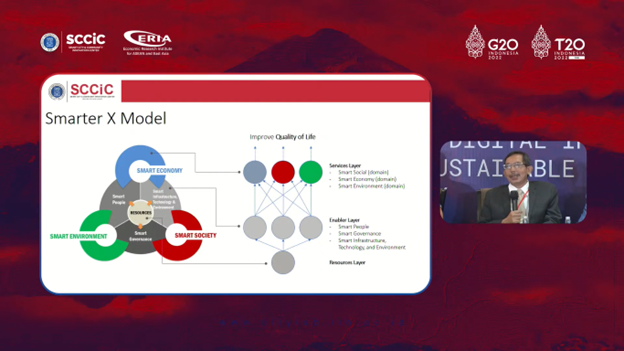Reminiscing the Traces of Life in the Universe by Observing the Night Sky
By Adi Permana
Editor Adi Permana

BANDUNG, itb.ac.id – The 5th episode of night sky observation held by Bosscha Observatory was held on Saturday (28/8/2021). The event, entitled "Traces of Life in the Universe" gives us chance to observe the night sky together and at the same time learning from astronomers. Prof. Dr. Taufiq Hidayat, DEA., an astronomer and lecturer in Astronomy at ITB, Agus Triono P. J. from the Bosscha Observatory, and Zulkarnain from Kupang, an amateur astronomer, attended this event.
Bosscha Observatory, the first and oldest modern observatory in Indonesia, was found in 1923. The observatory was built to ace astronomical science in the southern part of the Earth. Inside the observatory, we can find various telescopes and supporting instruments, computing facilities, and various kinds of libraries for researches.
Tiara Andamari, as the host, presented an introduction to the revolution in science, mainly to astronomy as an opening. She presented an interpretation of the sky, the earth, and the universe, which was born from the ancient civilizations. Further, she explained several theories from astronomers of ancient civilizations who had various models and ideas about the solar system.
Prof. Taufiq on the first presentation explained about the traces of life in the universe. “Life on earth, viewed from the point of view of science and what science understands, did not just suddenly appear. Life on earth is the product of a very long evolution. While complex living creatures only existed about 540 million years ago, the earth is more than 4 billion years old," he explained.
Life itself has several molecules composed from carbon atoms and requires an essential source of water and energy sources like sunlight. Simply, by looking at the solar system, we can look for life beyond earth. Scientists have debated that life also exists on Mars, Europe, Titan, and Venus.
However, these statements lead to many pros and cons, just like a scientist who discovered a canal on Mars and stated that the possibility of life on Mars and was debated by other cons statements.
“Turns out, Mars is not a comfortable place to live if compared to earth. Unlike earth, Mars has a very cold temperature and a very thin atmosphere that makes it easier for the ultraviolet radius and particles from the sun to reach the surface," said Taufiq
Further, a difference in atmosphere was found between earth and Mars, despite in being dominated by carbon dioxide like Mars in ancient times, due to evolution, the earth is now dominated by oxygen. "Until now, based on research on the planet Mars, we have not got any supporting evidence. Later in the future, the search will be continued with landings in areas with increasingly potential. The presence of water source becomes a further target," he explained.
Alongside the main presentation, there were also observations on Jupiter which was live streamed from the Bosscha Observatory by Agus PJ. Jupiter was seen, but the image was slightly blurry due to the air turbulence in these observations. We can also see the line on Jupiter’s appearance due to clouds activity on Jupiter’s rotation. “Different from earth, Jupiter only has 10 hours per day,” he explained. He also pitied another feature on the Jupiter, the great red spot, which was not visible that night.
Prof. Taufiq then further explained about Jupiter, Europa, Io, Titan, and Venus. Jupiter has a very active environment. Europe has cracks formed on them, along with a perpendicular surface line which is similar with winter coastlines. On the other hand, Titan has an everlasting blanket of fog mixed with organic compounds.
Just like Titan, Venus also has a fog blanket with a thickness of 70 meters. It contains sulfuric acid too. Due to the high surface pressure and temperature, some metals on the surface of Venus are foreseen to be melted. “However,” Prof. Taufiq added, “in very extreme conditions, not every living things cannot tolerate it.”
More, Prof. Taufiq explained about the Milky Way Galaxy as the formation of stars and planets to exoplanets. The presentation was closed with an explanation of intelligent civilization using technologies. “Many stars have been discovered, but are they occupied with advanced life?” he asked rhetorically.
“Search for extraterrestrial intelligence (SETI) is activities to search for creatures in this universe. Not only focusing to seek for life, but also for complex life. In fact, an intelligent life is exactly what are they looking for,” said Taufiq.
Agus then closed with his statement, “Also, when looking for life, we are not only focusing on life in the solar system. We also reach outwards, both to nebula and planets in other stars,"
The sighting of the Blue Horsehead Nebula (IC 4592) ended the observation. However, the image was not clearly visible due to several factors. “One of them is because the object is included in the reflection nebula. Therefore, it needs a higher sensitivity level of exposure. Reflection of light from street lamps also affected them, "explained Zulkarnain.
Reporter: Zahra Annisa Fitri (Perencanaan Wilayah dan Kota, 2019)
Translator: Tamara Maharani Alamsyah (Seni Rupa, 2020)

.jpg)
.jpg)
.jpg)
.jpg)
.jpg)


